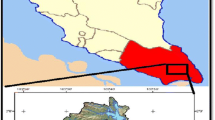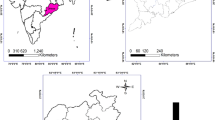Abstract
In the present study, the estimation of suspended sediment load is computed by four Artificial Neural Networks (ANNs) algorithms, Cascade Forward Back Propagation (CFBP), Feed Forward Back Propagation (FFBP), Radial Basis Function (RBF), and Recurrent Neural Network (RNN). Five cases of model input are calibrated to establish the relationship among precipitation, discharge and suspended sediment load. While discharge and rainfall up to four previous days as employed for input, model gives pre-eminent performance. Sensitivity of all models is appraised concerning Nash-Sutcliffe coefficient (ENS) and coefficient of determination (R2) for predicting sediment load. Among all ANNs, MMF (Morgan-Morgan-Finney) model when trained with stream flow as the input in RNN, gives best result with coefficient of determination, R2 as 0.9474, while the values for FFBP, CFBP and RBF are 0.9115, 0.8766 and 0.8511, respectively. Performance of all results show that an MMF model is superior to conventional SRC (Sediment Rating Curve) and MLR (Multiple Linear Regression) models in determining the complex relationship between discharge and suspended sediment load.








Similar content being viewed by others
References
Nourani V, Komasi M and Mano A 2009 A multivariate ANN-wavelet approach for rainfall–runoff modelling. Water Resources Management 23(14): 2877–2894 https://doi.org/10.1007/s11269-009-9414-5
Kisi O 2004 Multi-layer perceptrons with Levenberg Marquardt training algorithm for suspended sediment concentration prediction and estimation. Hydrological Sciences Journal 49(6): 1025–1040 https://doi.org/10.1623/hysj.49.6.1025.55720
Minns A W and Hall M J 1996 Artificial neural networks as rainfall runoff models. Hydrological Science Journal 41(3): 399–417
Fernando D A K and Jayawardena A W 1998 Runoff forecasting using RBF networks with OLS algorithm. Journal of Hydrologic Engineering 3(3): 203–209 https://doi.org/10.1061/(asce)1084-0699(1998)3:3(203)
Cigizoglu H K 2003 Incorporation of ARMA models into flow forecasting by artificial neural networks. Environmetrics 14(4): 417–427 https://doi.org/10.1002/env.596
Cigizoglu H K 2003b Estimation, forecasting and extrapolation of flow data by artificial neural networks. Hydrological Sciences Journal 48(3): 349–361 https://doi.org/10.2112/06-742.1
Jain S K 2001 Development of integrated sediment rating curves using ANNs. Journal of Hydraulic Engineering (ASCE) 127(1): 30–37 https://doi.org/10.1061/(asce)0733-9429(2001)127:1(30)
Cigizoglu H K 2002c Suspended sediment estimation for rivers using artificial neural networks and sediment rating curves. Turkish Journal of Engineering and Environmental Sciences 26(1): 27–36 https://doi.org/10.1061/40685(2003)173
Fang H W, Lai R X, Lin B L, Xu X Y, Zhang F X and Zhang Y F 2016 Variational-Based Data Assimilation to Simulate Sediment Concentration in the Lower Yellow River, China. J. Hydrologic Engineering 21(5): 04016010: 1–11
Merritt W S, Letcher R A, Jakeman A J 2003 A review of erosion and sediment transport models. Environmental Modeling and Software 18(8–9): 761–799 https://doi.org/10.1016/s1364-8152(03)00078-1
Agarwal A, Singh R D, Mishra S K, Bhunya P K 2005 ANN based sediment yield models for Vamsadhara river basin (India). Water SA 31(1): 95–100
Luk K C, Ball J E and Sharma A 2001 An application of artificial neural networks for rainfall forecasting. Journal of Math. Computer Model. 33:683–693 https://doi.org/10.1007/s11633-016-0986-2
Hidayat H, Hoitink A J F, Sassi M G and Torfs P J J F 2014 Prediction of Discharge in a Tidal River Using Artificial Neural Networks. J. Hydrologic Engineering 19(8): 04014006: 1–8
Singh V P, Cui H and Byrd A 2015 Sediment graphs based on entropy theory. J. Hydrologic Engineering 20(6):C4014004:1–10
Kumar D, Pandey A, Sharma N and Flügel W A 2015 Modeling suspended sediment using artificial neural networks and TRMM-3B42 version 7 rainfall dataset. J. Hydrologic Engineering 20(6): 1–12
Ghose D K and Samantaray S 2018 Modelling sediment concentration using back propagation neural network and regression coupled with genetic algorithm. Procedia Computer Science 125: 85–92
Rajaee T, Nourani V, Zounemat-Kermani M and Kisi O 2011 River suspended sediment load prediction: application of ANN and wavelet conjunction model. J. Hydrologic Engineering 16(8): 613–627
Ghose D K and Samantaray S 2019 Sedimentation process and its assessment through integrated sensor network and machine learning process. Computational intelligence in sensor network. 776: 473–488, Springer, Berlin, Heidelberg
Samantaray S and Ghose D K 2018 Evaluation of suspended sediment concentration using descent neural networks. Procedia Computer Science 132: 1824–1831
Author information
Authors and Affiliations
Corresponding author
Rights and permissions
About this article
Cite this article
Samantaray, S., Ghose, D.K. Sediment assessment for a watershed in arid region via neural networks. Sādhanā 44, 219 (2019). https://doi.org/10.1007/s12046-019-1199-5
Received:
Revised:
Accepted:
Published:
DOI: https://doi.org/10.1007/s12046-019-1199-5




